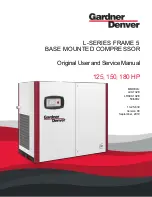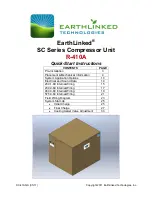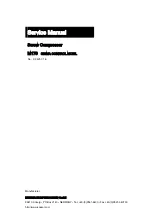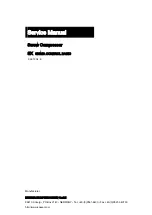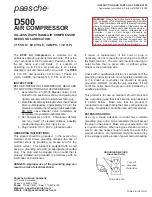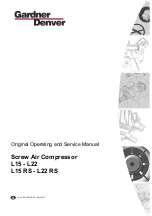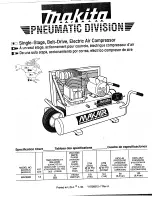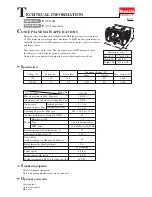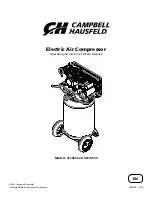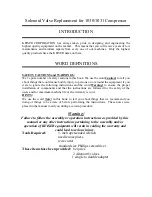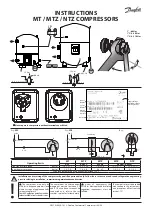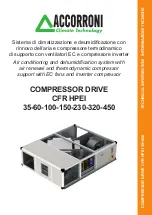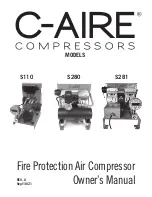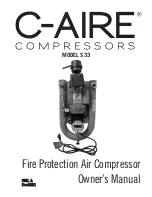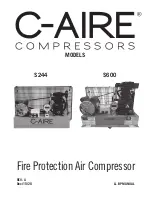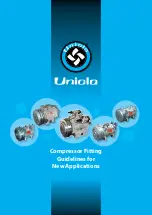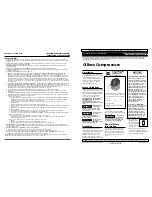
Gauge of Cord
18
14
12
10
8
8
6
6
4
Extension cords for 120V/8 Amp Unit
Length of Cord (ft)
25
50
100
150
200
250
300
400
500
Extreme Contractor Air Compressor Models
3
Installation (
Cont.)
grounding wire.
3. Check with a qualified electrician or
serviceman if grounding instructions
are not completely understood, or if in
doubt as to whether product is
properly grounded. Do not modify
plug provided; if it will not fit outlet,
have proper outlet installed by a
qualified electrician.
Never connect
green (or green and
yellow) wire to a live terminal.
Operation
FOR TROUBLE-FREE OPERATION
1. Read instructions: Carefully read
through this owner’s manual BEFORE
OPERATING the new air compressor.
It contains information about
operation and maintenance of unit.
Do not attach air
chuck or other tool
to open end of hose until start-up has
been completed and unit checks OK.
2. Turn regulator knob fully clockwise.
3. Turn switch to OFF position, and plug
in power cord.
4. Turn switch to ON position.
5. Turn regulator knob fully
counterclockwise. Compressor will
build to maximum preset pressure and
shut off.
6. Turn regulator knob counterclockwise
to shut off air and turn switch to OFF
position.
!
CAUTION
!
WARNING
7. Attach air chuck or other tool to open
end of hose. Turn regulator fully
clockwise (ON). Apply a soap and
water solution around hose fittings
and check for signs of leaks (bubbles
forming). If there is a leak, tighten
connections and check again. When
there are no leaks, compressor is ready
for operation.
Electric switch must
be turned off and
tank must be drained to below 10 psi
before any maintenance is performed on
the compressor.
8. Drain tank daily: Open drain cock and
drain moisture from tank. Be sure to
close cock tightly before operating
compressor. This helps prevent tank
corrosion and keeps oil and moisture
out of air used.
ASME SAFETY VALVE
1. This valve automatically releases air if
air receiver pressure exceeds preset
maximum.
Do not attempt to
tamper with this
valve!
2. This valve should be checked
occasionally by pulling the ring by
hand. Air may leak even after ring has
been released. However, if the leaking
continues for an extended period of
time, or if the safety valve is stuck and
cannot be activated by the ring, the
safety valve MUST be replaced. (Note:
Valve will reset when tank pressure
reaches 40-50 PSI.)
!
DANGER
!
WARNING
REGULATOR KNOB
1. This knob controls air pressure to an air
operated tool, paint spray gun or nailer.
2. Turning knob clockwise increases air
pressure at outlet.
3. Turning counterclockwise will lower air
pressure at outlet.
4. Fully counterclockwise will shut off flow
of air completely.
REGULATED OUTLET GAUGE
1. This gauge shows at-a-glance, air
pressure at outlet. Air pressure is
measured in pounds per square inch
(psi).
2. Be sure this gauge reads ZERO before
changing air tools or disconnecting hose
from outlet.
TANK PRESSURE GAUGE
Gauge shows pressure in air receiver
indicating compressor is building pressure
properly.
MOISTURE IN COMPRESSED AIR
Moisture in compressed air will
form into droplets as it comes
from an air compressor pump.
When humidity is high or when a
compressor is in continuous use
for an extended period of time,
this moisture will collect in the
tank. When using a paint spray or
sandblast gun, this water will be
carried from the tank through the
hose, and out of the gun as
droplets mixed with the spray
material.
IMPORTANT:
This condensation
will cause water spots in a paint
job, especially when spraying
other than water based paints. If
sandblasting, it will cause the
sand to cake and clog the gun,
rendering it ineffective.
A filter in the air line, located as
near to the gun as possible, will
help eliminate this moisture.
18 Sp
Compresores de Aire
Problema
Posible(s) Causa(s)
Acción a Tomar
1. Conecciones flojas (coneciones,
tuberías, etc.)
2. La llave de salida está floja
3. Hay fugas en la válvula de chequeo
1. Excesiva cantidad de agua en el
tanque de aire
2. Humedad alta
1. Presostato está dañado
2. Excesivo uso de aire
Pernos están flojos
1. Válvulas de entrada están rotas
2. Fugas en las conecciones
1. Chequée todas las conecciones con agua enjabonada
y apriete las conecciones flojas
2. Apriete la llave
3. Lleve el compresor a un centro de servicio Campbell
Hausfeld autorizado
Antes de desmantelar la
válvula de chequeo
purgue el aire del tanque
1. Drene el tanque
2. Mueva el compresor a un área menos humeda; use
un filtro de línea
1. Lleve el compresor a un centro de servicio Campbell
Hausfeld autorizado
2. Disminución del uso de aire; el compresor no es lo
suficientemente grande para los requerimientos de su
herramienta
Apriete los pernos
1. Lleve el compresor a un centro de servicio Campbell
Hausfeld autorizado
2. Apriete las conecciones
!
PELIGRO
La presión del tanque
disminuye cuando el
compresor se apaga
Exceso de humedad en
el aire de salida
Compresor funciona
constantemente
Compresor vibra
El suministro de aire es
menos de lo normal
Guía de Diagnóstico de Averías (Continuación)
www.chpower.com
Figure 2
Close
Open
Figure 4
Figure 5
Figure 3
Figure 6
Close
Open







